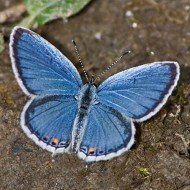Lycaenidae is the second-largest family of butterflies (behind Nymphalidae, brush-footed butterflies), with over 5,000 species worldwide whose members are also called gossamer-winged butterflies. They constitute about 30% of the known butterfly species.
The family is traditionally divided into the subfamilies of the blues (Polyommatinae), the co...
Lycaenidae is the second-largest family of butterflies (behind Nymphalidae, brush-footed butterflies), with over 5,000 species worldwide whose members are also called gossamer-winged butterflies. They constitute about 30% of the known butterfly species.
The family is traditionally divided into the subfamilies of the blues (Polyommatinae), the coppers (Lycaeninae), the hairstreaks (Theclinae) and the harvesters (Miletinae); others include the Lipteninae, Liphyrinae, Curetinae and Poritiinae, but some authorities also include the family Riodinidae within the Lycaenidae
Adults are small, under 5 cm usually, and brightly coloured, sometimes with a metallic gloss.
Larvae are often flattened rather than cylindrical, with glands that may produce secretions that attract and subdue ants. Their cuticles tend to be thickened. Some larvae are capable of producing vibrations and low sounds that are transmitted through the substrates they inhabit. They use these sounds to communicate with ants.
BUTTERFLIES ARE SOLD FOLDED IN PAPILLOTES NOT SPREAD AS WELL
